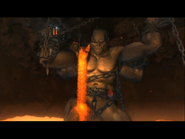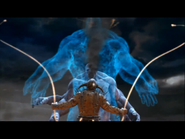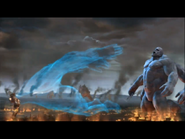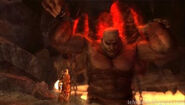| “ | You are strong, but you are far too small, even for an Olympian, to be a god. | ” |
–Atlas. | ||
Template:Infobox gods Atlas is one of the mighty Titans that once had dominion over the world. After their fall from grace, Atlas would cooperate with the goddess Persephone in order to destroy the world, but was defeated by Kratos. Defeated and contained, Atlas was forced to carry the world on his shoulders, as he would forever remain at the top of the Pillar of the World.
Greek Mythology
In Greek mythology, Atlas was a second generation Titan born from the union of the first generation Titans Iapetus and Asia, two of the children of Ouranos and Gaia. When Zeus overthrew Cronos, Atlas joined the Titans in the Great War. After the Titans were defeated, Atlas was the Titan who was forced to forever separate Gaia, the earth, and her husband, Ouranos, the sky, from each other, preventing any further union from them.
In one version of the myth, he was turned to stone by Perseus using Medusa's head, turning him into the Atlas mountains in North Africa. He is famously shown in sculpture and other forms of art carrying a sphere upon his shoulders. This has eventually led to the misconception that he is carrying the world, whereas in classical Greek mythology, he holds up the sky.
At one point, he is given a reprieve to retrieve the Golden Apples for Hercules as part of a deal they made: Atlas will get the apples while Hercules holds up the sky. Atlas obtains the apples as promised but does not wish to take back the job of holding the sky from the earth. Hercules tricks the Titan by stating he will do the job but wants to shift his shoulders to make it easier. Atlas takes hold of the sky again, but to his dismay, Hercules takes the Golden Apples and leaves.
He was known to the Canaanites as Dagon.
In the God of War Series
The mighty Atlas is depicted with four arms to show he holds up the sky. A prime example of misconception exists throughout the series as, whether deliberate or a mistake, Atlas is seen holding up the world atop of the Underworld. One reason for this could be to avoid confusion; in western society, the word 'atlas' is most commonly associated with cartography, so it would make sense for the Titan to hold the Earth rather than the Heavens.
Great War
During the Great War of the Gods and the Titans, Atlas along with Cronos, the King of the Titans, led the Titans in the battle against the Gods. He was the strongest Titan, capable of hurling mountains at the gods like mere pebbles. While Hades tried to absorb the soul of Cronos, Atlas the mighty Titan unleashed his fury by pounding the ground, causing a massive earthquake. Although he saved his Titan brethren from being captured, Atlas was then targeted by Hades. With the aid of Poseidon, Atlas’ soul was successfully obtained and absorbed by Hades. Despite his capture, however, the Titans continued their battle against the Gods. The weakened Atlas awoke within the deepest pits of the Underworld, where his fellow Titans would meet him by the end of the Great War.
God of War: Chains of Olympus
The Pillar of the World
Thousands of years after the Great War, Atlas was freed from his torture within Tartarus by the goddess Persephone, who wished for him to destroy the Pillar of the World, ending the life for all beings. Atlas tore Helios from the sky, causing the light to disappear from the world and the Earth to plunge into darkness. The Gods fell into a deep slumber through the sleeps of the Dream God Morpheus. Using the power of the sun, Atlas began to destroy the Pillar of the World.
It was not before long that Kratos, the Champion of the Gods, confronted Persephone and Atlas. The Ghost Of Sparta quickly disposed of the treacherous goddess, and soon took on the enormous Titan, who had already partially destroyed the Pillar of the World. Kratos had previously managed to chain Atlas into upholding the empty space between the Pillar of the World and the world itself, causing him to bear the weight on his shoulders.
Staring at Kratos, Atlas asked Kratos if the Gods would indeed help him. He warned the Spartan that they would meet again, as the Sisters of Fate had deemed it. Atlas’ curse was given to him by a mere mortal, which would be something he would never forget for as long as he lived.
God of War II
Aiding Kratos
While Kratos traversed the Island of Creation, he was confronted by the crazed Icarus. Icarus attacked Kratos, pushing Kratos along with himself, off the cliffs leading to the Temple of the Sisters of Fate, where a battle would ensue. Kratos managed to subdue Icarus, and by using his wings landed on the Titan he enchained many years ago– Atlas.
Kratos destroyed one of the chains which held Atlas in place, relieving part of the Titan's burden, but gaining attention from him. Atlas, who was not pleased to see Kratos, grabbed him and tried to crush Kratos between his index finger and thumb, but Kratos manages to avoid being crushed, albeit with some apparent difficulty. Atlas, disgraced by Kratos’ presence, asked how Kratos could dare show his face after what he had done. When Kratos revealed his intentions towards Zeus, since he betrayed Kratos by draining him of his godly powers and animating a statue, forcing him to focus his remaining god powers into the Blade of Olympus (a powerful weapon that ended the Great War of the Gods and the Titans) to fight back while further weakening him, Atlas told him of the Great War and Zeus’ bloodlust and power-hungry desire to rule over mortals. Atlas claims that the Titans knew they had to win for the benefit of the mortals, but it is possible that he may have been not telling the full truth, considering that he appeared to be willing to destroy the world just to get revenge on Zeus. Atlas then tested Kratos and after he passed the test, Atlas gifted Kratos with the last of his magic, granting him the Atlas Quake. Believing Kratos to truly be a worthy ally of the Titans, Atlas granted Kratos passage through the Great Chasm by lifting him to the surface.
The Second Titanomachy
During the Second Titanomachy, Atlas is presumed to still carry the world on his shoulders, including during the events of the second Titanomachy. He is, however, mentioned when Helios reminds Kratos of the debt that he owes him.
Personality
Just like the other titans, Atlas is extremely prideful and feels a deep hatred toward the olympians, he hates the gods so much that he was willing to destroy the whole world, even if this action would kill him as well, only to achieve his revenge against the olympians. However, Atlas can be more reasonable than some of the other titans, as when he helped Kratos to escape the underworld, even though the spartan was the responsible for imprisioning him.
Powers and Abilities
Atlas was one of the strongest and largest titan, possessing a variety of abilities:
- Immortality: Atlas, as most titans is an immortal being that doesn't age biologically, is immune to disease and can't be killed with mortal weapons. He could however be killed by Gods, Titans and Primordials, as well as with divine weapons, like the Blade of Olympus.
- Power Bestowal: After Kratos revealed his plans to kill Zeus at Atlas, the latter bestowed him with the magical ability, known as Atlas' Quake, to help him on his quest.
- Superhuman Durability: Atlas is incredible durable, having lava flowing over his back, erroding his skin, yet not showing any discomfort for it. During the Titanomachy, it took the combined power of two of the strongest Olympians, Poseidon and Hades, to take him down.
- Superhuman Stamina: Atlas held up the Pillar of the Earth for many years, without showing any sign of tiring.
- Superhuman Strength: Atlas is the strongest of the titans, able to hold up the Pillar of the Earth on his shoulders. He is also the only known Titan with four arms, increasing his physical strength even further.
- Terrakinesis: Atlas is able to hurl boulders the size of mountains, cause earth quakes that even can shake Gods from their feet and summon large boulders of stone and magma by slamming his fists in the ground.
Trivia
- Menoetius, brother of Atlas, known to be as powerful as him, fought the Great War and faced a fierce duel with Zeus, but his hubristic attitude got the better of him and allowed Zeus to hit the ground with his lightning, destroying it, and Menoetius fell to a deadly encounter with the soil of Tartarus, killing him. This might implies that the hole in the ceiling of Tartarus was created when Zeus fought him.
- In the first God of War game, in Pandora's Temple, there's a statue of Atlas, but it looks almost nothing like how Atlas is depicted in the other two games. The possible explanation is that Pathos Verdes III, the architect, had never seen or heard of his appearance, thus creating a statue entirely based on his own thoughts.
- The Challenge of Atlas, or the whole entire Pandora's Temple, must have been created after God of War: Chains of Olympus, because this is when Atlas held up the world.
- It's probable that the Challenge of Atlas was built long before his imprisonment at the Pillar of the World, and that Pathos Verdes III simply built it as a challenge to the visitors, later renaming it the Challenge of Atlas, after learning what happened to the real Atlas. That would explain why the Atlas statue looks nothing like the real one, but its most likely that ordinary mortals like Pathos knew nothing of Atlas appearance and personality, he probably just knew him from the myths and designed the challenge as a reference.
- The best theory is that the construction of Pandora's Temple was in progress during the events of Chains of Olympus and the part of the Challenge of Atlas and the rest of the Temple was built after Pathos learned the myth.
- In God of War: Chains of Olympus, Atlas is voiced by Fred Tatasciore. In God of War II, Atlas is voiced by the late Michael Clarke Duncan who is best known for playing John Coffey in The Green Mile.
- He is the brother of Prometheus whom Kratos met and freed from his torment in God of War II.
- He is the father of the Pleiades, the 7 nymphs that accompany Artemis.
- He is also the grandfather of Hermes, since one of his daughters, Pleiades Maia bore him through Zeus.
- He is the only Titan in the series who has four arms.
- It took two of the most prominent Gods of Olympus, Hades and Poseidon, to bring down Atlas in the Titanomachy, however, Kratos alone defeated Atlas in Chains of Olympus (but he needed the Gauntlet of Zeus.)
- Atlas is now the last living Titan since he never appeared in God of War III, meaning he continued to hold the world on his back; otherwise, if he had died, the world would have fallen apart. Rhea could possibly be alive due to the fact that she hid her son Zeus from Cronos. This would make them the last remaining Titans.
- He is one of the few characters who knew Kratos and wasn't killed by him like the Oracle of Athens, Typhon, Aphrodite, Artemis, the Body Burner, and Deimos.
- In Greek Mythology, Atlas was the Titans' leader in the Titanomachy. He was reserved a special punishment to hold the skies on his back. His daughters, the Hesperides, planted their garden at his feet.
- Given Atlas' accusations that Kratos would regret "what he had done" (i.e., save all existence from destruction, including Elysium), it's very possible Atlas had been deceived by Persephone into thinking destroying the Pillar would only kill Zeus and the Olympians. The fact that the Pillar is actually under the Island of Creation and not Mount Olympus supports this. And it seems more realistic as it is very unlikely that a Titan would help a Goddess.
- Years of being seared by molten magma has damaged Atlas, causing portions of his skin to become rough, rocky, and to corrode away all together.
- Atlas is about the same size of Cronos, 1600 feet tall. This makes them amongst the tallest of the Titan race. That makes them even bigger than Gaia.
- They are likely dwarved by the Primordials however, whose broken body parts formed the earth.
- The Atlas character models in God of War II and Chains of Olympus are significantly smaller than the Cronos character model in God of War III.








